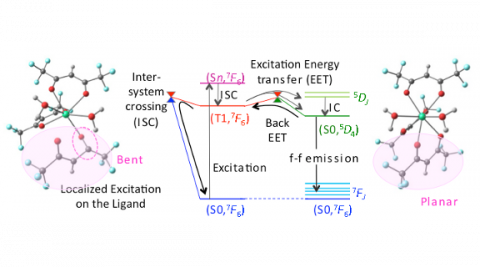Simulations of Chemical Reactions of Complex Molecular Systems

The f-f emission of lanthanide complexes is widely used as thermosensor. The emission process proceeds with the initial excitation from the ground singlet S0 state, followed by intersystem crossing (ISC) to the lowest triplet T1 state, excitation energy transfer (EET) from the ligand T1 to a lanthanide 4f5 5DJ state, internal conversion (IC) from the 5DJ to the 5D4 state, and the f-f green emission. If ISC from T1 to S0 competes with these events, the emission is weakened. For three Tb3+ complexes, transition states and crossing states for these events have been determined by the use of the recently developed Global Reaction Route Mapping (GRRM) strategy, and the origin of the temperature dependency of emission intensity has been identified.
M. Hatanaka and K. Morokuma, Exploring the reaction coordinates for f-f emission and quenching of lanthanide complexes – thermo-sensitivity of terbium(III) luminescence. J. Chem. Theo. Comp. 2014, 10, 4184-4188.